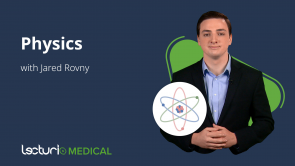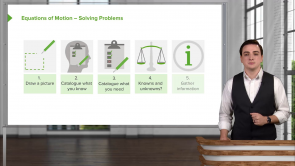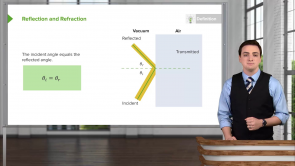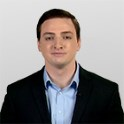Mirrors and Lenses

About the Lecture
The lecture Mirrors and Lenses by Jared Rovny, PhD is from the course Geometrical Optics.
Included Quiz Questions
Which of the following rays would pass through the focal point of a concave mirror after reflection?
- A ray of light incoming to a circular concave mirror and parallel to the mirror axis.
- A ray of light incoming to a circular concave mirror perpendicular to the mirror axis.
- A ray of light passing through the center C of the mirror and non-parallel to the mirror axis.
- A ray of light passing through the focal point of the mirror and non-parallel to the mirror axis.
- A ray of light passing through the mid point between the focal point and the center of the mirror and non-parallel to the mirror axis.
Why is light from a distance source approximately parallel upon arrival at a mirror?
- Any light emitted from the distant source at a slightly different angle from the direction of the mirror will diverge more and more over longer distances, missing the mirror.
- Any light that is not parallel will destructively interfere over long distances.
- A non-parallel ray will destructively interfere with other non-parallel rays upon arrival at the mirror.
- Parallel rays always constructively interfere, such that at long distances they dominate the amount of light.
- Mirrors act as focusers of light, causing the beams to become parallel over long distances.
Consider light rays that are emitted from a point on an object. How can the intersection point of the reflection of these light rays off a mirror act as an effective location for a “source” of light?
- A source emits light in all directions which allows us to be able to see the source. The point of intersection of the reflected lights can also act as an effective location for a source of light as it emits light in all directions.
- Since whenever two beams intersect, they form an image at the point of intersection.
- When two beams intersect, the focal point and the center of a mirror coincide for the image to come into focus for an observer.
- Since whenever there are parallel rays emitted to a mirror their reflection passes through the focal point which creates an image there.
- The point of intersection of two beams emerging from any two points on the object can always act as a new source of light.
An object sits outside the focal point of a concave mirror. What is the simplest approach in finding the location of the image of this object?
- Trace a ray that is parallel to the axis of the mirror from the tip of the object, this ray reflects through the focal point of the mirror. Trace another ray from the tip of the object through the focal point of the mirror, this ray reflects parallel to the axis of the mirror. The point of intersection of these two rays will be the location of the tip of the objects image.
- Trace two parallel rays to the axis of the mirror one from the tip of the object and another from the middle of the object. The point which their reflection intersects will be the location of the objects image.
- Trace a ray that is parallel to the axis of the mirror from the tip of the object, this ray reflects through the focal point of the mirror. Trace another ray from the tip of the object through the center of the mirror, this ray reflects parallel to the axis of the mirror. The point of intersection of these two rays will be the location of the tip of the objects image.
- Trace two rays one from the tip of the object and another from the middle of the object through the focal point of the mirror. The point which their reflection intersects will be the location of the objects image.
- None of the other choices accurately describes the location of the image.
These courses may be of interest to you
Customer reviews
5,0 of 5 stars
| 5 Stars |
|
5 |
| 4 Stars |
|
0 |
| 3 Stars |
|
0 |
| 2 Stars |
|
0 |
| 1 Star |
|
0 |








